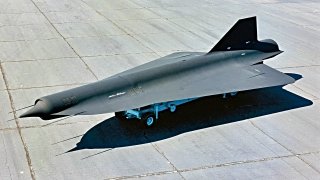Lockheed D-21: The Mini SR-71 Blackbird Drone That Spied of China's Nuclear Bombs
Unfortunately, the wreckage of a twelfth Lockheed D-21 is now on display at the Chinese Aviation Museum in Beijing. It serves as a testament to the failure of the program.
The Lockheed D-21 Was More Than a Mini-Version of the SR-71 Blackbird - The concept of "military drone" is one that is often associated with the 21st century, but actually dates back more than a century. In fact, the first drones were essentially radio-controlled target aircraft that took flight during the First World War.
Fast forward a half-century, and the technology had advanced considerably.
Meet the D-21 – The Drone Designed to Spy on China
During the Cold War, Lockheed developed the D-21, a supersonic reconnaissance drone that could be launched from the back of an M-21 carrier aircraft – a variant of the Mach 3+ A-12 spy plane. Originally designed for the Central Intelligence Service (CIA) and the United States Air Force surveillance missions over particularly hostile territories, the D-21 was a remotely piloted aircraft (RPA) that utilized technology from the A-12/YF-12/SR-71 "Blackbird" family of high-speed manned planes.
As with the other members of the A-12 family, the D-21 was developed by the famed Lockheed "Skunk Works" in the 1960s. However, it was the smallest of the aircraft to come out of the program, and the D-21 had a wingspan of 19 feet and was just under 43 feet in length.
Its launch weight was 11,000 pounds and it had a service ceiling of 95,000 feet. Moreover, unlike the turbojet engines that were employed in the Blackbird, the D-21 was actually powered by a Marquardt ramjet engine, which could reach speeds in excess of 2,000 miles per hour (3,200 km/h). The drone was designed to be launched from the back of a heavily-modified two-seat A-12, which acted as a "mother ship" and was designated an M-21, while the D-21 served as the "daughter."
Initial testing of the D-21 began in 1963, but an actual drone release test wasn't conducted until March 1966. Three subsequent successful test flights were conducted, but the fourth flight ended in disaster after the D-21 suffered engine problems and struck the M-21's tail after separation – leading to the destruction of both aircraft. While the two crew members ejected and landed at sea, only Pilot Bill Park survived. Tragically Launch Control Officer Ray Torrick drowned.
Kelly Johnson, the leader of the Skunk Works, even suggested that the D-21 be modified and adapted to be launched from a U.S. Air Force B-52 Bomber. Those later models, designated D-21B utilized a large, solid-propellant booster rocket for launch and to generate the speed required for engine operation.
Technical Specs
Engine: One Marquardt RJ43 ramjet of 12,000 lbs. thrust
Maximum speed: 2,000+ mph (Mach 3+)
Range: 3,000 miles
Ceiling: Approx. 95,000 feet
Mission Failure?
Testing of the modified aircraft began in 1967, and eventually, the D-21 was used in four operational missions over Communist China under the code name "Senior Bowl." During each reconnaissance mission, the D-21 drone flew on a pre-programmed path over areas of interest, and then returned to international airspace, where the film package, equipped with its own parachute, was ejected.
That package was recovered in mid-air by a specially equipped airplane or at sea by a ship. After the film package was jettisoned, the drone self-destructed.
It wasn't an especially efficient method, and it was costly. Even worse for the U.S. taxpayer was the fact that the missions typically ended in failure. As a result, in 1971 the United States Air Force canceled the program and the remaining aircraft of the total 38 produced were put in storage.
Surviving Aircraft
Eleven of the surviving D-21Bs are now on display at military and aviation museums in the United States including Aerospace Maintenance and Regeneration Group (AMARG) located on Davis-Monthan AFB, Tucson, Arizona; Blackbird Airpark, Palmdale, California; Evergreen Aviation Museum, McMinnville, Oregon; Grissom Air Museum, Grissom Air Reserve Base, Peru, Indiana; March Field Air Museum, March Air Reserve Base, Riverside, California; Museum of Aviation, Robins Air Force Base, Georgia; the National Museum of the United States Air Force, Wright-Patterson Air Force Base, Ohio; Pacific Coast Air Museum, Sonoma County, California; and Pima Air & Space Museum (adjacent to Davis-Monthan AFB), Tucson, Arizona.
The Museum of Flight in Seattle is notable in that its D-21 is even mounted on a remaining M-21.
Unfortunately, the wreckage of a twelfth D-21 is now currently on display at the Chinese Aviation Museum in Beijing. It serves as a testament to the failure of the program.
About the Author
Peter Suciu is a Michigan-based writer who has contributed to more than four dozen magazines, newspapers and websites. He regularly writes about military hardware, firearms history, cybersecurity and international affairs. Peter is also a Contributing Writer for Forbes.


